
Matthew Barry
Auburn University
Analysis of Mechanical Stresses/Strains in Superconducting Wire
Matthew Barry, Jingping Chen, Yuhu Zhai
The optimization of superconducting magnet performance and development of high-field superconducting magnets will greatly impact the next generation of fusion devices. A successful magnet development, however, relies deeply on the understanding of superconducting materials. Among the numerous factors that impact a superconductor’s performance, mechanical stress is the most important because of the extreme operation temperature and large electromagnetic forces. Typical superconducting wires consist of a stabilizer, a barrier, a matrix and superconducting filaments. In previous work, J. Chen developed a model to calculate the stresses/strains in individual Nb3Sn filaments embedded in a matrix. In this study, mechanical theory is used to further develop this model by modeling the barrier and stabilizer. Both thermal loads and mechanical loads are included in the analysis to simulate operation conditions. Because the combination of these models will sim- ulate the typical architecture of major superconducting materials, such as Nb3Sn, MgB2, Bi-2212 etc., it will provide a good overall picture for us to understand the behavior of these superconductors in terms of thermal and mechanical loads.
Poster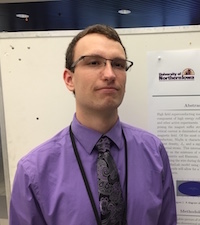
Lucas Beving
University of Northern Iowa
Describing the Effects of Voids in Nb3Sn Superconducting Wire Using Finite Element Analysis
Lucas Beving, Yuhu Zhai
High field superconducting magnets are a necessary component of high energy colliders, fusion devices, and other active experiments. When the wires comprising the magnet suffer structural damage, the critical current is diminished and thus the resultant magnetic field. Of the most commonly used superconductors, Nb3Sn is characterized by the highest current density, Jsigma, and a significant susceptibility to internal strain. This internal strain is greatly dependent on the existence of voids within both the copper matrix and filaments. These voids are created withing the wire during the heat treatment process. A MatLab model using randomly distributed elliptical voids will allow for a better understanding of their effects.
Poster
Alexandra Bosh
Virginia Tech
X Ray Detection and Analysis for the PFRC
Alexandra Bosh, Charles Swanson, Sam Cohen
Studying x rays produced during interactions between electrons and ions in a plasma is a crucial part of the experimentation process when using the PFRC-2 device. This device is one of many different types of concept fusion reactors. In order for our device to function properly there are specific values of necessary characteristics (the plasma pressure, confinement time, stored energy and beta value) that the plasma must have. Measuring the energy levels of x rays and the amount of x rays produced during a known time, or the count rate, are necessary steps when determining the specific values of the characteristics. What I worked on this summer was the process of detecting the x rays and using this data to determine if the PFRC-2 device was functioning properly. The research consisted of collecting the data while testing was conducted, analyzing this data to indicate the properties of the plasma. This information was then used to determine what parameters were needed to be altered for future experiments.
Presentation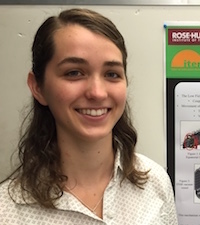
Rachel Broughton
Rose-Hulman Institute of Technology
Mechanical Design, Testing, and Simulation of Self-Aligning Gaussian Telescope and Test Stand for ITER LFS Reflectometer Diagnostic
Rachel Broughton, Michael Gomez, Ali Zolfaghari, Lewis Morris
Engineers at the Princeton Plasma Physics Laboratory designed a self-aligning Gaussian telescope to be used for a microwave coupling diagnostic device on the International Thermonuclear Experimental Reactor (ITER). The transmission line of this device, made up of waveguides, passes through the vacuum vessel of ITER. The purpose of the self-aligning mechanism is to compensate for the movements caused by thermal expansion across the vacuum vessel. A test stand to hold the mechanism was designed in order to simulate the motions it will undergo when being used at ITER. The motions of the test stand, as well as the stress on the telescope mechanism, were virtually simulated using ANSYS workbench, a computer program that was new to me. A prototype of this stand and self-aligning telescope were built using a combination of custom machined parts and pre-made fasteners. The completed prototype will be tested at the lab in four different ways: slow movements, rapid movements, laser alignment, and natural frequency. Once the prototype successfully passes all requirements, it will be tested with microwaves in the low field side reflectometer transmission line test stand at General Atomics. For this project to be successful, collaboration occurred between the machine shop workers, multiple PPPL employees, another intern, and engineers at General Atomics. Thus, I was able to develop my professional communication skills which were necessary throughout the process. I learned the importance of being adaptable in the workplace as all the components of a large-scale project do not turn out as expected. Being in the environment of PPPL, I began to learn the jargon used at the lab, become familiar with technical aspects of plasmas, and understand the big picture concepts. I realized the important role of fusion and plasmas in our world and how I can contribute to the field as a future Ph.D. student.
Poster
David Caron
The College of New Jersey
Wall Conditioning Characterization in NSTX-U
David Caron, V. Soukhanovskii, F. Scotti, M. Weller
Impurities in NSTX-U’s tokamak can lead to disruptive instabilities due to radiative energy loss. One source of impurities in NSTX-U comes from water trapped in the graphite diverter plates. Water ionizes and produces H and O impurities. Therefore, by using spectroscopy and a residual gas analyzer (RGA) the source and amount of released impurities can be better characterized. To do this a high resolution visible light spectrometer gathered H/D data from the top, lower, and center stack diverters. The RGA gave information on what the environment of the tokamak was before and after the shot. From this, relative trends in the H and O impurities from the diverters are found. These trends are dependent on the type of wall conditioning done on the tokamak and how long since the last conditioning.
Poster
Rian Chandra
University of Washington
Characterization and Improvement of Infra-Red Video Bolometry Camera and Codes for NSTX-U
Rian Chandra, Matt Reinke, Byron Peterson, G.G. Van Eden, Ryuchi Sano
The Infra-Red Video Bolometer (IRVB) currently installed on NSTX-U has the potential to dramatically improve understanding of radiated power losses through the acquisition of 2- D, high time resolution data. The IRVB does this by measuring the temperature change of a plasma-facing Pt foil, and then reconstructing the input power profile through a Crank- Nicholson numeric interpretation of the 2-D heat equation. This project seeks understand the limitations of and build on the existing analysis codes, and compare performance of three IRVB cameras with a single-channel IR photoconductive bolometry (IRPB) system, who’s feasibility is also explored in depth. Through analysis of calibration movies where the foil was heated with a laser of known power and frequency, we find that the codes cannot accurately reconstruct the power amplitude by a scale factor, which is largely constant over input power density. The reason for this is not known, but foil thickness and thermal diffusivity, blackbody calibration, Spatial and Temporal binning, output averaging area and location, reflectivity and other factors have been ruled out as culprits. We further find that while the measured Signal-to-Noise Ratio (SNR) of the constructed ThorLabs IRPB is within a factor of three vs the predicted value, it is overall significantly lower than the IRVB at similar settings. However, predicted SNR values for other sensor brands approach IRVB measured values, at similar cost-per-channel. We find significant reductions in SNR when the full heat equation is applied, vs the raw signal. Finally, significant increases in computational speed were achieved via code vectorization, making the data conversion and processing feasible on an inter-shot timescale. These results are presented in a time and space integration insensitive metric, the “Sensor NEPD”.
Poster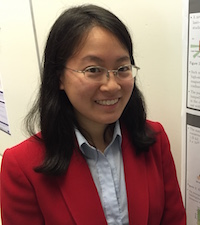
Jessica Cheng
Brown University
Magnetic Field Generation by a Laser-Driven Capacitor-Coil Target
Jessica Cheng, Lan Gao
Magnetic fields generated by currents flowing through a capacitor-coil target were characterized using ultrafast proton radiography at the OMEGA EP Laser System. Two ~1.25 kJ, 1ns laser pulses propagated through the laser entrance holes in one foil of the capacitor, and were focused to the other with an intensity of ~3 × 1016 W/cm2. The intense laser-solid interaction induced a high voltage between the foils and generated a large current in the connecting coil. The proton data show tens of kA current producing tens of Tesla magnetic fields at the center of the coil. Theoretical lumped circuit models based on the experimental parameters were developed to simulate the target behavior and calculate the time evolution of the current in the coil. The models take into account important elements such as plasmas conditions for building up the voltage, the capacitance between the gap, the resistive heating and skin effect to gain insights on the field generation mechanism. Applications to other coil geometries and magnetic field configurations will also be described.
Poster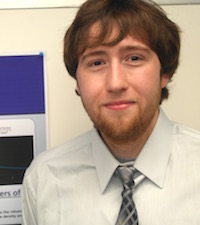
Matthew Feurer
Seton Hall University
Calculating Particle Densities in Carbon Arc Plasmas
Matthew Feurer, Vladislav Vekselman
Since the discovery of different allotropes of carbon in the twentieth century many uses have been found for carbon nanotubes (CNT’s). Considered by many as a miracle material carbon nanotubes have been incorporated into many materials with the hopes that it can transfer its conductive and high tensile strength properties. These uses include transistors, plastic composites, high strength cables, and thin films. With various technologies incorporating Carbon nanotubes into their design there is an increasing need to produce high quality carbon nanotubes on a larger scale. Using arc discharge has become a promising technique for producing high quality CNT’s with a possibility to scale designs for larger production rates. With arc discharge being such a promising technique it is important to control parameters in order to control the exact specification of carbon nanotubes produced. This project however is not focused on structure, but looks purely at the physics governing volumetric growth. In this project we have looked at instabilities in a carbon arc plasma and calculated how they could potentially effect particle densities. We also propose a mechanism and model for these dense clouds of particles that are observed. Based on this model we estimate number of particles in these clouds.
Poster
Sam Frank
University of Michigan
Design of a Fiber Coupled Laser Interferometry System for FLARE
Sam Frank, Jongsoo Yoo
The Facility for Laboratory Reconnection Experiments (FLARE), which is currently under construction at PPPL, requires a complete set of laboratory plasma diagnostics. The Langmuir probes that will be used in the device to gather local density data require a reliable density diagnostic to serve as a calibration baseline. A fully fiber-coupled laser heterodyne Michelson interferometer has been designed and is currently being tested to serve as the primary line-integrated electron density diagnostic. The basic principles governing interferometer construction in plasma devices, design of the interferometer to be used in FLARE, the phase detection system to be used with this system, and finally future plans involving system implementation will be discussed.
Poster
Akhil Ghanta
Duke University
Addition of Anomalous Transport Module to XGCa
Akhil Ghanta, R. Hager, M. Churchill
The promise of fusion energy is a source of virtually unlimited power. A technology with such prowess, however, is not an easy task to achieve. The race for fusion has been ongoing for nearly fifty years with great success towards finally achieving commercially viable fusion reactors. At the forefront of fusion technologies are Tokamak reactors. Typically helical in geometric structure, the hope is for Tokamaks to take up the role of commercial reactors. Nevertheless, Tokamaks are still some ways from achieving self-sustaining fusion reactions or “ignition.” The primary problems include the short time period for which plasma can be confined and the problems of heat loss due to plasma collisions with the wall and diffusive effects that are dubbed as anomalous transport. The project I partook in this summer aimed to efficiently simulate the turbulence caused by plasma diffusion in a Tokamak. The project took place within the a gyrokinetic particle-in-cell code called XGC-axisymmetric or XGCa. XGCa was designed to model the edge pedestal in the density and temperature profiles of Tokamak fusion plasmas. Before I arrived at PPPL, the code handled charged particle interactions, neutral particle collisions, losses due to the wall, and other effects that are typically observed within Tokamaks. What it lacked, however, was code to simulate plasma turbulence. In my project I developed Fortran modules to effectively simulate these effects. I used a finite-element discretization to solve the temperature and density diffusion equations at each point in the plane of the Tokamak. I then integrated my modules into the existing code by updating the overall distribution function.
Poster
Ben Y. Israeli
Columbia University
Simulation of Scrape-Off Layer Magnetic Field in W7-X
B.Y. Israeli1, S. Lazerson, S. Hudson, T. Andreeva, S. Bozhenkov, the W7-X Team
The W7-X stellarator at the Max-Planck-Institut für Plasmaphysik has recently begun operation and is projected to run for extended pulses under fusion-relevant conditions. In the recently completed operation phase, the plasma edge was limited by five graphite stripes placed on the inboard wall of the device. In the upcoming operational phase, a divertor system will replace the limiters. The divertor consists of a series of graphite plates positioned to intersect magnetic islands at the edge of the plasma. Particles at the edge of the plasma will be guided by the magnetic field onto the divertor plates. This allows the divertor to function as a heat and particle exhaust. The proper operation of both the limiter and divertor systems is dependent upon the geometry of the magnetic field. Asymmetries could potentially lead to an uneven load on the system. In this work, such asymmetries are investigated by numerical tracing of the magnetic field. As a metric of load applied to the limiter, the connection length of the fieldlines intersecting the limiter is determined. The resulting pattern matches with previous work, and changes in this pattern due to misalignment and deflection of the coils were determined. The effect of field errors on the divertor system were investigated using a simplified diffusion model. Since charged particles roughly follow fieldlines, performing a random walk while tracing fieldlines results in an approximate model of particle diffusion. This model was applied to the divertor configuration, providing insight into the effect of coil misalignment on divertor load distribution.
Poster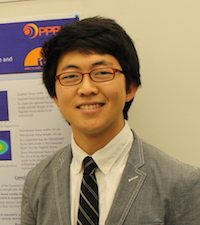
HeeSeok Joo
University of Virginia
Use of Gaussian Beam Tracing in the Design of Millimeter-Wave Diagnostics on ITER
H. Joo, M. Bitter, B. Tobias, H. Park, A. Zolfaghari
The diffraction effect cannot be ignored once the wavelength of light becomes comparable to the optical components, which makes the geometrical optics not the most useful technique to use. Instead, Gaussian beam tracing can be used by treating the propagation of the light as a beam propagating and distributing outward with certain size rather than a ray when analyzing the optics of millimeter-wave diagnostics. Gaussian optics is an effective way to represent diffraction effect in optical system because of its ability to show the beam size and the intensity that could be altered from diffraction. The new concept of using spherical mirrors for electron cyclotron emission imaging (ECEI) presents more realistic method of ECEI in ITER than previous idea of using cylindrical mirror that requires large access ports that can be exposed to intense neutron radiation, whereas the spherical mirror system requires smaller aperture on the first wall of ITER. The instrument is designed to shift based on the temperature, which could alter the imaging property of the beam emitted from plasma. The purpose of the Gaussian telescope is to correct the outgoing beam to focus. Gaussian beam tracing method was applied and a simple experiment was done in order to analyze the beam propagation and the diffraction effects.
Poster
Joseph Labrum
University of California Berkeley
Superheated Bubble Detector Test Bench for Zero-Knowledge Warhead Verification
Joseph Labrum, Sebastien Philippe, Rob Goldston
Superheated droplet detectors, or bubble detectors, are emulsions of fluorocarbon droplets homogeneously dispersed in an aqueous gel matrix. These non-electronic detectors can be manufactured to be sensitive only to neutrons above a certain energy threshold without being sensitive to gamma rays, and have the ability to record the total fluence at which they were exposed during multiple exposures. Recently, bubble detectors have been used in the first experimental demonstration of a physical zero-knowledge protocol for nuclear warhead verification. Such a protocol can confirm that two objects are identical without revealing their geometry or composition, and could play an important role in the next round of nuclear arms control agreements that may require inspection of individual warheads. A follow up experiment to discriminate special nuclear materials of identical geometry but different isotopic composition, without learning what these properties are, is currently being developed at PPPL. As part of this experiment, we are developing a test bench to implement advanced optical and laser bubble counting techniques for the careful characterization of bubble detectors. In particular, we are looking to increase our capacity to adequately measure greater detector exposure (~1000 bubbles) in order to increase the statistics of our measurements, as well as study the physical mechanisms of bubble aging. Such system should be able to take high-resolution videos of the detectors including during exposure to 14-MeV neutrons. Concurrently to the development of the test bench and further work in the development of the main experiment, which require the careful characterization of the neutron field produced by our new 14-MeV DT neutrons generator shielded in a large collimator. This work involves both Monte Carlo simulations and experimental measurements using fast neutron scintillator detectors.
Poster
Nick McGreivy
University of Pennsylvania
UEDGE Simulations of a Direct Fusion Drive FRC Rocket
Nick McGreivy, Amir Raja, Eugene Evans, Sam Cohen
The field-reversed configuration (FRC) is being considered for use as a terrestrial power plant and as a direct- fusion-drive rocket engine for future space missions in the solar system. To produce thrust for a rocket or extract energy for electricity production, an asymmetric SOL has been proposed in which coolant/propellant gas is injected into a gas box at one end of the SOL. Plasma formed in the gas box flows along the SOL and its electrons are heated as they pass near the FRC core. The heated plasma is then ejected out a magnetic nozzle at the opposite end. We have used a 2D fluid code, UEDGE, to conduct numerical simulations of this FRCs SOL. We have examined the effects of power input from the FRC core (1-4 MW) and gas flow into the gas box (0.01-0.5 grams per second) on the rockets thrust (1-100 N) and specific impulse (ca. 1.5e5 s) as well as on the power flow within the SOL. One important result is that the high plasma flow out of the gas box and the cold plasma within it reduce the power flow into the gas box well below 50% of the input power. Plasma dynamics of the gas box region have been investigated to assess the degree of detachment that can be obtained for given performance requirements. Finally, an FRC is evaluated for performance as a direct-fusion-drive rocket engine.
Poster
Joseph Mittelstaedt
University of Chicago
STELLTRANS: A transport analysis suite for stellarators
J. Mittelstaedt, S. Lazerson, N. Pablant, G. Weir, M. Landreman, The W7-X Team
The stellarator transport code STELLTRANS allows us to better analyze the power balance in W7-X. Although profiles of temperature and density are measured experimentally, geometrical factors are needed in conjunction with these measurements to properly analyze heat flux densities in stellarators. The STELLTRANS code interfaces with VMEC to find an equilibrium flux surface configuration and with TRAVIS to determine the RF heating and current drive in the plasma. Stationary transport equations are then considered which are solved using a boundary value differential equation solver. The equations and quantities considered are averaged over flux surfaces to reduce the system to an essentially one dimensional problem. We have applied this code to data from W-7X, shot number 16030910, and were able to calculate the heat flux coefficients. We will also present extensions of the code to a predictive capacity which would utilize neoclassical transport code to find transport coefficients to update the temperature and density profiles.
Poster
Tahiri Nuñez
Hudson County Community College
Computer Simulations of Magneto-Rotational Instability
Tahiri Nuñez, Erik Gilson, Kyle Caspary, Fatima Ebrahimi, Hantao Ji
It is believed that Magneto-Rotational Instability (MRI) is primarily responsible for the transport of angular momentum in accretion disks. We ran simulations using the Spectral Finite Element Maxwell and Navier- Stokes (SFEMaNS) code (J.-L. Guermond, et al. Nonlinear magnetohydrodynamics in axisymmetric heterogeneous domains using a Fourier/nite element technique and an interior penalty method. J. Comp. Phys., 228:2739-2757, 2009.) to create synthetic diagnostics that help us understand and compare results with what has been measured in laboratory experiments at Princeton. Simulations results are shown to help to understand the behavior of the radial and axial velocity of the flow and magnetic field induced in the MRI experiment; always taking in consideration that the device used in experiments does not completely resemble an accretion disk: the geometry of the container that holds the liquid Gallium creates the possibility of other instabilities occurring that we have to identify and sort out in order to recognize MRI. We analyze data for several time-steps, changing different parameters such as rotation speed, and induced magnetic field, in order to determine whether a steady state is reached, or whether there are fluctuations that can be measured.
Poster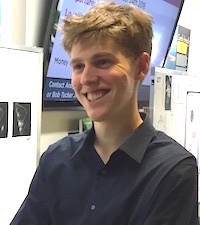
Jonah Philion
Harvard University
Deuterium Neutral Beam Orbits in NSTX-U Nonaxisymmetric Vacuum Magnetic Fields
J. Philion, D. Darrow, G. Kramer
Axisymmetry of the tokamak magnetic field provides good fast ion radial confine- ment. Perturbations from this symmetry could induce fast ion radial diffusion and loss. A nonaxisymmetric perturbation was chosen to model the effect of this symmetry loss on NSTX-U deuterium neutral beam ions. Passing and banana orbits in the perturbed field were simulated by integrating the Lorentz force over a duration shorter than the collision time of ions. Upon comparison with analogous orbits in the unperturbed field, the perturbation is shown to have a dispersive effect on the magnetic moment and canonical angular momentum of particle orbit guiding centers causing passing orbits to leave. Furthermore the dispersion in Pφ is shown to be correlated with dispersion in magnetic moment μ.
Poster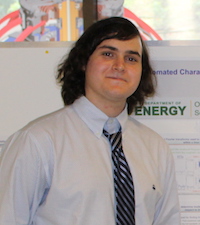
Juan D. Riquezes
University of Michigan
Automated Characterization of Rotating MHD Modes and Subsequent Locking in a Tokamak
J.D. Riquezes, S.A. Sabbagh, J.W. Berkery
A key cause of plasma disruptions in tokamaks is the physical event chain that comprises the appearance of rotating magneto-hydrodynamic (MHD) modes, their slowing by resonant field drag mechanisms, and their subsequent locking. The present research aims to define algorithms to automatically find and characterize such physical event chains in the machine database. Characteristics such as identification of a mode locking time based on a loss of torque balance and bifurcation of the mode rotation frequency are examined to determine the reliability of such events in predicting disruptions. A goal is to detect such behavior as early as possible during a plasma discharge, and to further examine potential ways to forecast it. This capability could be used to provide a warning to use active mode control as a disruption avoidance mechanism, or to trigger a controlled plasma shutdown if desired.
Poster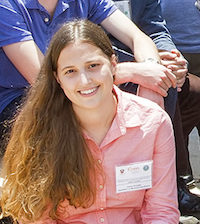
Hannah Schamis
University of Michigan
Initial analysis of boronized TZM samples exposed to NSTX-U plasmas with MAPP
H. Schamis, F. Bedoya, R. Kaita, J. P. Allain
In the National Spherical Torus Experiment Upgrade (NSTX-U) a new plasma facing component diagnostic, the Material Analysis and Particle Probe (MAPP), was installed. MAPP has the capability of conducting XPS studies on materials without exposing them to atmospheric conditions. MAPP was used to conduct XPS studies of TZM (99% Mo, 0.5% Ti, 0.08% Zr) samples. XPS gives information about the chemical composition of up to about 5 nm of the surface, and can be conducted on a day-to-day basis or at higher temporal resolutions e.g. close to in-between plasma shots. MAPP characterization gives insight on boron deposition and fuel retention by following the evolution of atomic concentrations and oxidation states. The data shows that the boron deposited layer was thicker than 5 nm. Additionally, the data shows evidence of sputtering of the boron layers following tens of plasma shots. The data also shows an increase in the oxygen concentration with plasma exposure. The next NSTX-U experimental campaign will feature TZM tiles in the lower divertor region, while the rest of the first wall will continue to be ATJ graphite. Our data provides the basis to analyze how the surface chemistry of the new set of tiles will be influenced by plasma operations, boron conditioning and carbon migration.
Poster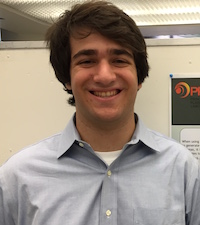
Joseph Seibert
University of Michigan
Parametric Study of HTS Coil Quench Protection Strategies
Joseph Seibert, Mike Zarnstorff, Yuhu Zhai
Next generation fusion devices require high magnetic fields to adequately contain plasmas. Use of high temperature superconducting (HTS) coils to generate these magnetic fields would lower energy cost of operation as well compared to resistive coils as well as increase stability of the superconducting state compared to low temperature superconducting coils. However, use of HTS coils requires developing quench protection systems to quickly extract energy from the coils during quench scenarios to prevent damage to the coils. One energy extraction technique involves the utilization of copper discs mutually coupled to the HTS coil to more quickly extract the current from the coil. This project describes a parametric study of the coil and disc setup in order to determine limiting cases of the geometry in an attempt to optimize current extraction during quench scenarios.
Poster
David Shaw
University of Notre Dame
Visualization of Electron Beam Propagation
David Shaw, Igor Kaganovich
The Earth’s magnetic field can be approximated as that of a magnetic dipole at close distances (i.e. within a few Earth radii). However, this approximation degrades further away, and becomes especially non-realistic during solar storms as the solar wind pressure modifies the field quite drastically. It has been proposed that by injecting a beam of relativistic charged particles from a satellite in space at the magnetic equator and detecting the subsequent atmospheric presence of particles within the loss cone, details about the magnetic field more than a few Earth radii away can be ascertained. In order to visualize this beam as it propagates, Python was used to script animations of this beam in time. A view anti-parallel to the direction of beam propagation is established, as well as two views perpendicular to the direction of propagation, thus allowing a viewer to see along the longitudinal and transverse axes of the beam. These animations will help to visualize the dynamics and spread of the beam in space during its motion.
Poster
Roman Sherrod
University of Tennessee
Thermal Gravimetric Analysis of Lithium Oxidation in Air
Roman Sherrod, C.H. Skinner
Liquid lithium plasma facing components (PFCs) are being developed to handle long pulse, high heat loads in tokamaks. Wetting by lithium of its container is essential for this application, but can be hindered by lithium oxidation by residual gases or during tokamak maintenance. Lithium PFCs will experience elevated temperatures due to plasma heat flux. This work presents measurements of lithium reactions at elevated temperatures (298-373 K) when exposed to natural air. Cylindrical TZM wells 300 microns deep with 1 cm2 surface area were filled with metallic lithium in a glovebox containing argon with < 1.6 ppm H20, O2, and N2. The wells were transferred to a hot plate in air, and then removed periodically for mass gain measurements. Changes in the surface topography were recorded with a microscope. The mass gain of the samples at elevated temperatures followed a markedly different behavior to that at room temperature. Increasing temperature from 25 to 150 degrees C results in a decrease in initial mass gain rate. In addition, samples at 100 and 150 degrees C diverged, with some samples rapidly gaining mass between 20 and 30 hours.
Poster
Steven Stemmley
University of Illinois at Urbana-Champaign
Hydrodynamic MagnetoRotational Instability Analog Experiment
Steven Stemmley, Eric Blackman, Kyle Caspary, Erik Gilson, Derek Hung, Hantao Jia, Peter Sloboda
The MagnetoRotational Instability (MRI) is thought to be responsible for angular momentum transport in accretion disks. This transport occurs when two magnetically coupled fluid elements are perturbed and radially stretch the sufficiently weak magnetic field. To mimic these astrophysical systems, a modified Taylor-Couette device was operated with water as the working fluid at varying rotation speeds to produce hydrodynamic, quasi-Keplerian flows and with a pair of test masses coupled by a spring rather than a magnetic field. This scaled experiment simulates the spring-like forces between fluid elements brought on by magnetic tension. In attempts to visually observe this MRI analog, neutrally buoyant masses of varying size were coupled by means of a spring to a fixed point rotating with the fluid. Laser Doppler Velocimetry showed good agreement with ideal Taylor- Couette velocity profiles and that no significant perturbations were present when the masses were moving at the speed of the flow. Further investigations include varying the masses, springs, and shear profiles to obtain a map of the instability threshold boundary as well as determining the effect of the mass’s geometry on the flow. Results from video recording measurements and analyses are presented and discussed.
Poster
Phil Travis
University of Illinois at Urbana-Champaign
Dependence of profiles and edge stability on NSTX neutral beam power
Phil Travis, G.P. Canal, T.H. Osborne, R. Maingi, S.A. Sabbagh, the NSTX-U Team
Studying the effect of neutral beam injected (NBI) power on edge plasma profiles and magne- tohydrodynamic (MHD) stability is central to the understanding of edge-localized modes (ELMs). Higher heating power should quicken the development of pressure and current-driven peeling- ballooning modes. NSTX ELMy H-mode discharges with NBI power of 4, 5 and 6 MW were analyzed with a python-based set of analysis tools that fit plasma profiles, compute kinetic equi- libria, and evaluate the MHD stability with the code ELITE. Electron density and temperature from Thomson scattering measurements, and ion density, temperature, and rotation from Charge Exchange Recombination Spectroscopy were inputs to the kinetic equilibrium fits. The power scan provides an opportunity to compare the stability calculations from the ELITE (ideal) and M3D-C1 (resistive) codes. Preliminary analysis shows that edge pressure profiles for the 5 and 6 MW dis- charges are comparable, suggesting they both reach a stability boundary. The 4 MW case shows lower edge pressure, which is likely limited by edge transport below the edge stability boundary.
Poster
William Wallace
Laney College
Development of the ThomsonViz Application for NSTX-U
W. Wallace, A. Diallo
MultiPoint Thomson Scattering (MPTS) is an established, accurate method of finding the temperature, density, and pressure of a magnetically confined plasma. Two Nd:YAG (1064 nm) lasers are fired into the plasma with a effective frequency of 60 Hz, and the light is Doppler shifted by Thomson scattering. Polychromators on the NSTX-U midplane collect the scattered photons at various radii/scattering angles, and the avalanche photodiode voltages are saved to an MDSplus tree for later analysis. IDL code is then used to determine plasma temperature, pressure, and density from the captured polychromator measurements via Selden formulas. Previous work developed a rudimentary visualization application in Python for displaying time- based signals as loaded from an MDS data storage tree. In addition to two time based signals, the application allowed a data customer to select a specific moment in time during a specific shot and find the nearest time-matched Thomson diagnostic data across the NSTX-U torus. A zoom function also allowed a 'drill down' to a specific region of the torus to identify phenomena for further study. This work extended the previous application into a much more robust tool to be used by any researcher at PPPL to quickly find and view data. In addition, many new features were developed; a full documentation set was written, and the application prepared for deployment onto the PPPL computing cluster.
Poster